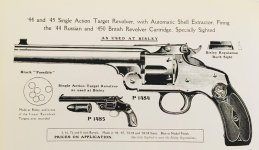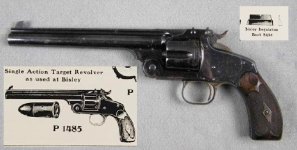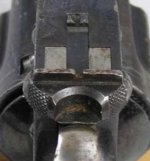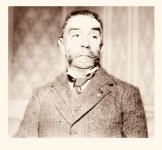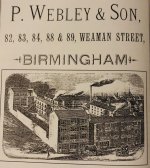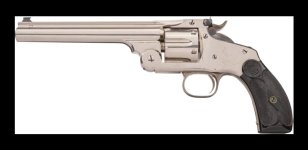TripleLock
Member
Doing a search within this forum I came across this ad (date and source not stated) illustrating the New Model No.3. The larger illustration, noted as P 1484, appears to be the "standard" target model of the NM3, complete with Paine front sight and the regular adjustable target rear sight. It was the illustration at the upper right of the "Bisley Regulation Back Sight", however, that interested me most as I have in my possession a NM3 with precisely that same sight and which is virtually identical to the revolver identified as P 1485... complete with the distinctive "shark fin" front sight.
My revolver, serial no. 34022, shipped August 5, 1903, to Charles Osborne & Co., Birmingham, England, and is chambered for the .450 Revolver (aka .450 Adams, or .450 Eley) cartridge which was popular on the ranges at Bisley from the 1870s and into the years preceding WWI, and it bears marks on the barrel, cylinder, and frame from the Birmingham proof house. The letter for this revolver states it shipped with 8 inch barrel, adjustable target rear sight, blue finish, and checkered walnut grips. No mention of the front sight is made. The letter indicates that this revolver was one of a shipment of 12 identical revolvers. Serial numbers match on the butt, rear of the cylinder, underside of the extractor, rear of the barrel, underside of the barrel catch, and inside the right stock panel. Measuring the barrel, I find it to be 7-1/2 inches, which I originally questioned. However, the muzzle is properly crowned, the rib stops just where the radius of the crown meets the O.D. of the barrel, and the barrel address marking is perfectly centered between the front sight and the beginning of the top strap. An inquiry was made to Roy Jinks regarding the barrel length, and it is his opinion that the barrel is, indeed, as it originally left the factory and that the information was incorrectly recorded by the shipping clerk who, as he said, never actually saw the revolver before it shipped, but merely recorded the "standard" length. It is also notable that Bisley regulations allowed a barrel of no more than 7-1/2 inches.
I have included a composite image of my NM3 with the Bisley rear sight and P 1485 revolver superimposed for comparison, and additional images of the rear sight. The sight is adjusted by means of loosening a small screw on the underside of the barrel catch then drifting the blade to the left or right and tightening the screw to secure it. The final image is one I took after I had assembled a few appropriate cartridges, made from shortened .455 MkII cases, a 226 grain hollow base bullet, and an appropriate charge of BP. The original cartridge was loaded with 13 grains of BP, but with modern cases the most I could manage was 10 grains.
Jim
My revolver, serial no. 34022, shipped August 5, 1903, to Charles Osborne & Co., Birmingham, England, and is chambered for the .450 Revolver (aka .450 Adams, or .450 Eley) cartridge which was popular on the ranges at Bisley from the 1870s and into the years preceding WWI, and it bears marks on the barrel, cylinder, and frame from the Birmingham proof house. The letter for this revolver states it shipped with 8 inch barrel, adjustable target rear sight, blue finish, and checkered walnut grips. No mention of the front sight is made. The letter indicates that this revolver was one of a shipment of 12 identical revolvers. Serial numbers match on the butt, rear of the cylinder, underside of the extractor, rear of the barrel, underside of the barrel catch, and inside the right stock panel. Measuring the barrel, I find it to be 7-1/2 inches, which I originally questioned. However, the muzzle is properly crowned, the rib stops just where the radius of the crown meets the O.D. of the barrel, and the barrel address marking is perfectly centered between the front sight and the beginning of the top strap. An inquiry was made to Roy Jinks regarding the barrel length, and it is his opinion that the barrel is, indeed, as it originally left the factory and that the information was incorrectly recorded by the shipping clerk who, as he said, never actually saw the revolver before it shipped, but merely recorded the "standard" length. It is also notable that Bisley regulations allowed a barrel of no more than 7-1/2 inches.
I have included a composite image of my NM3 with the Bisley rear sight and P 1485 revolver superimposed for comparison, and additional images of the rear sight. The sight is adjusted by means of loosening a small screw on the underside of the barrel catch then drifting the blade to the left or right and tightening the screw to secure it. The final image is one I took after I had assembled a few appropriate cartridges, made from shortened .455 MkII cases, a 226 grain hollow base bullet, and an appropriate charge of BP. The original cartridge was loaded with 13 grains of BP, but with modern cases the most I could manage was 10 grains.
Jim
Attachments
Last edited:

